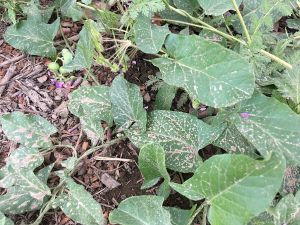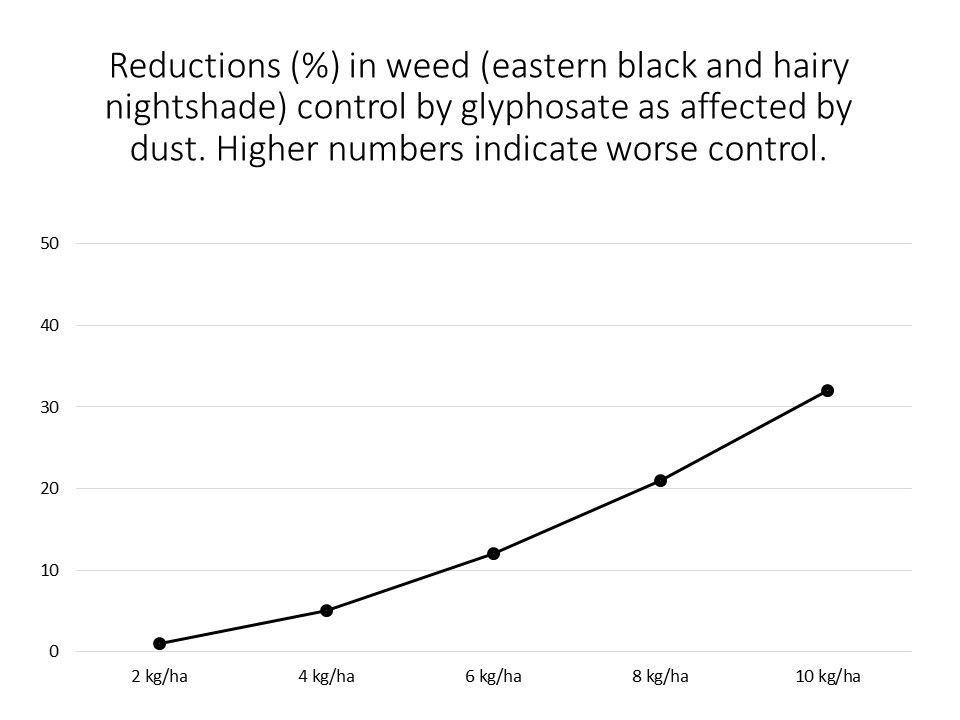Written by Lynn M. Sosnoskie, WSU Weed Science
Glyphosate is one of the most widely used herbicides in the United States (including in tree fruits) for the post-emergent weed management. First registered under the trade name Roundup™ in 1974, glyphosate became a popular crop protection chemical due to its systemic nature, broad spectrum of weed control, and lack of soil residual activity (Miller et al. 2013; Zhou et al. 2006). Glyphosate came off patent in 2000 and is currently marketed under dozens of different trade names (such as Durango™, Rodeo™, Roundup PowerMax™, Touchdown™, among others) in more than 100 crops.
Glyphosate lacks soil activity. According to Zhou et al. (2006): ‘Clay mineral type and content, organic matter fraction, pH, and cation exchange capacity are potential factors that may affect herbicide adsorption.’ Soil dust that settles on weed leaf surfaces (Figure 1) or dirt that is deposited on weeds from the tires of farm vehicles can negatively impact glyphosate performance because of binding and subsequent inactivation (i.e. binding of the glyphosate to the soil particles, which prevents uptake by the plants).

Zhou et al. (2006) conducted a series of studies to describe the effects of dust on glyphosate efficacy. In one trial, they evaluated how the control of two weed species (eastern black (Solanum ptychanthum) and hairy (Solanum sarrachoides) nightshades) were affected by dust amounts. Results showed that increased rates of dust applied to the surface of weed leaves (prior to or within 15 minutes after glyphosate applications) resulted in reduced control (Figure 2). Additional studies demonstrated that the use of adjuvants (ammonium sulfate, a non-ionic surfactant, and an organosilicone surfactant) were not able to completely overcome the effect of dust. A similar type of trial was conducted by Boerboom et al. (2006) at two field locations in Wisconsin. Dust (generated using a lawn mower or leaf blower was deposited over the top of common lambsquarters (Chenopodium album). Dust was removed from ½ of the plots with water and the entire trial was sprayed glyphosate. At both locations, the application of dust visually reduced common lambsquarters relative to the plots that had the dust washed away with water.

In addition to dust on plant surfaces, soil particles in spray water can also bind to glyphosate and reduce herbicide efficacy. As such, only clean water should be used to fill spray tanks.
In summary:
- Be mindful of how soil disturbance (from in-orchard activities, from road traffic) affects dust production.
- Make glyphosate applications in advance of periods when dust production may be heightened.
- Sprinkler irrigation may be able to remove some of the dust from leaves. Glyphosate applications should be made after weed leaves have dried and before more dust can be deposited.
References:
Boerboom, C. et al. (2006) Factors affecting glyphosate control of common lambsquarters. Proceedings of the North Central Weed Science Society 61:54.
Miller, T. et al. (2013) Glyphosate stewardship: Maintaining the effectiveness of a widely used herbicide. ANR Publication 8492. https://anrcatalog.ucanr.edu/pdf/8492.pdf
Zhou, J. et al. (2006) Soil dust reduces glyphosate efficacy. Weed Science 54:1132-1136.
Contact
 Lynn M. Sosnoskie, Ph.D.
Lynn M. Sosnoskie, Ph.D.
Assistant Research Faculty, Washington State University
Tree Fruit Research and Education Center
Wenatchee, WA 98801
@LynnSosnoskie on Twitter
Phone: 229-326-2676
Disclaimer: No endorsement is intended for products mentioned, nor is lack of endorsement meant for products not mentioned. The author and Washington State University assume no liability resulting from the use of pesticide applications detailed in this report. Application of a pesticide to a crop or site that is not on the label is a violation of pesticide law and may subject the applicator to civil penalties up to $7,500. In addition, such an application may also result in illegal residues that could subject the crop to seizure or embargo action by WSDA and/or the U.S. Food and Drug Administration. It is your responsibility to check the label before using the product to ensure lawful use and obtain all necessary permits in advance.
